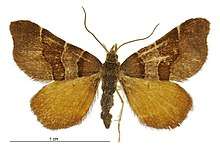Cephalissa
Cephalissa is a monotypic moth genus in the family Geometridae. Its only species, Cephalissa siria, the orange triangle moth, is endemic to New Zealand. This species has been classified as nationally vulnerable by the Department of Conservation.
| Cephalissa | |
|---|---|
 | |
| Male | |
| Scientific classification | |
| Kingdom: | |
| Phylum: | |
| Class: | |
| Order: | |
| Family: | |
| Subfamily: | |
| Genus: | Cephalissa Meyrick, 1883 |
| Species: | C. siria |
| Binomial name | |
| Cephalissa siria Meyrick, 1883[2] | |
| Synonyms | |
| |
Taxonomy
This genus and species were described by Edward Meyrick in 1883 using specimens collected by Frederick Hutton in Dunedin.[3][4] In 1898 George Vernon Hudson described and illustrated the species under the name Hydriomena siria.[5] Hudson also used the same synonym when he described and illustrated the species in his 1928 publication.[6] John S. Dugdale also discussed the species in 1975.[7] The lectotype specimen is held at the Natural History Museum, London.[8]
Description
Meyrick described the species as follows:
16-18 mm. Forewings moderate, costa sinuate, hind-margin strongly sinuate; rather dark reddish-fuscous, markings darker; a narrow curved fascia towards base, posteriorly obscurely edged with yellowish-white; a median band, moderately broad on costa, much narrower towards inner margin, both margins obscurely edged with yellowish-white, only distinct on costa, anterior margin sinuate, posterior margin sinuate, somewhat projecting in middle; an indistinct suffusion towards apex. Hindwings moderate, hindmargin irregular, obtusely projecting in middle; bright deep orange, tinged with reddish-fuscous on hindmargin; cilia dark fuscous.[9]
Distribution
This species is endemic to New Zealand.[2][4] Along with the type locality of Dunedin, Hudson noted that the species was also present at the Waihopai Scenic Reserve near Invercargill. In 1939 Hudson mentioned that the species was present in the Waianiwa and Takitimo mountains in Southland.[10] This species has suffered a contraction of its range.[6] It is no longer seen in Dunedin nor Invercargill, but is still present in eastern Otago and in the Rongahere Gorge on the Clutha River.[11] It has been located in the Dansey Ecological District which is regarded to be the northern limit of its range.[12] The species has also been located at the Mt Watkin Scenic Reserve, north of Dunedin.[13]
Habitat
Hudson stated that the species was seen in kahikatea forest amongst Carex species.[6] C. siria is also known to inhabit the short tussock grasslands and shrubland in the Dansey Ecological District.[12]
Biology and life cycle
The adult moths are on the wing in October and November.[6]
Conservation status
This moth is classified under the New Zealand Threat Classification system as being nationally vulnerable.[1]
References
| Wikimedia Commons has media related to Cephalissa siria. |
- Hoare, R.J.B .; Dugdale, J.S.; Edwards, E.D.; Gibbs, G.W.; Patrick, B.H.; Hitchmough, R.A.; Rolfe, J.R. (2017). Conservation Status of New Zealand Butterflies and Moths (Lepidoptera), 2015 (PDF). Wellington, New Zealand: New Zealand Department of Conservation. p. 6. ISBN 9781988514383.
- "Cephalissa siria Meyrick, 1883". New Zealand Organisms Register. Landcare Research New Zealand Ltd. Retrieved 3 May 2018.
- Meyrick, Edward (1883). "Monograph of New Zealand Geometrina [abstract]". New Zealand Journal of Science. 1: 526–531. Retrieved 3 May 2018.
- Gordon, Dennis P., ed. (2010). New Zealand Inventory of Biodiversity. Volume Two. Kingdom Animalia: Chaetognatha, Ecdysozoa, Ichnofossils. Vol. 2. Christchurch, N.Z.: Canterbury University Press. p. 459. ISBN 9781877257933. OCLC 973607714.
- Hudson, George Vernon (1898). New Zealand Moths and Butterflies (Macro-lepidoptera). London: West, Newman & co. p. 51. Retrieved 4 May 2018.
- Hudson, G. V. (1928). The Butterflies and Moths of New Zealand. Wellington: Ferguson & Osborn Ltd. p. 98.
- Dugdale, J.S. (1971). "Entomology of the Aucklands and other islands south of New Zealand: Lepidoptera, excluding non-crambine Pyralidae" (PDF). Pacific Insects Monograph. 27: 55–172.
- Dugdale, J. S. (1988). "Lepidoptera-annotated catalogue, and keys to family-group taxa" (PDF). Fauna of New Zealand. 14: 1–264 – via Landcare Research New Zealand Ltd.
- Meyrick, Edward (1884). "A monograph of the New Zealand Geometrina". Transactions and Proceedings of the New Zealand Institute. 16: 49–113. Retrieved 3 May 2018.
- Hudson, George Vernon (1939). A Supplement to the Butterflies and Moths of New Zealand. Wellington: Ferguson & Osborn. p. 406. OCLC 9742724.
- Patrick, Brian; Dugdale, John S. (2000). Conservation Status of the New Zealand Lepidoptera (PDF). Wellington, N.Z.: Department of Conservation, New Zealand. ISBN 0478218672. OCLC 154670803.
- Patrick, Brian (1991). Insects of the Dansey Ecological District (PDF). Wellington: Department of Conservation, New Zealand. ISBN 0478012853. OCLC 154612987.
- Kelvin Lloyd (March 2015). Beyond Orokonui:Volume 1: Indigenous biodiversity (PDF) (Report). Wildland Consultants Ltd. p. 29. Retrieved 4 May 2018.
